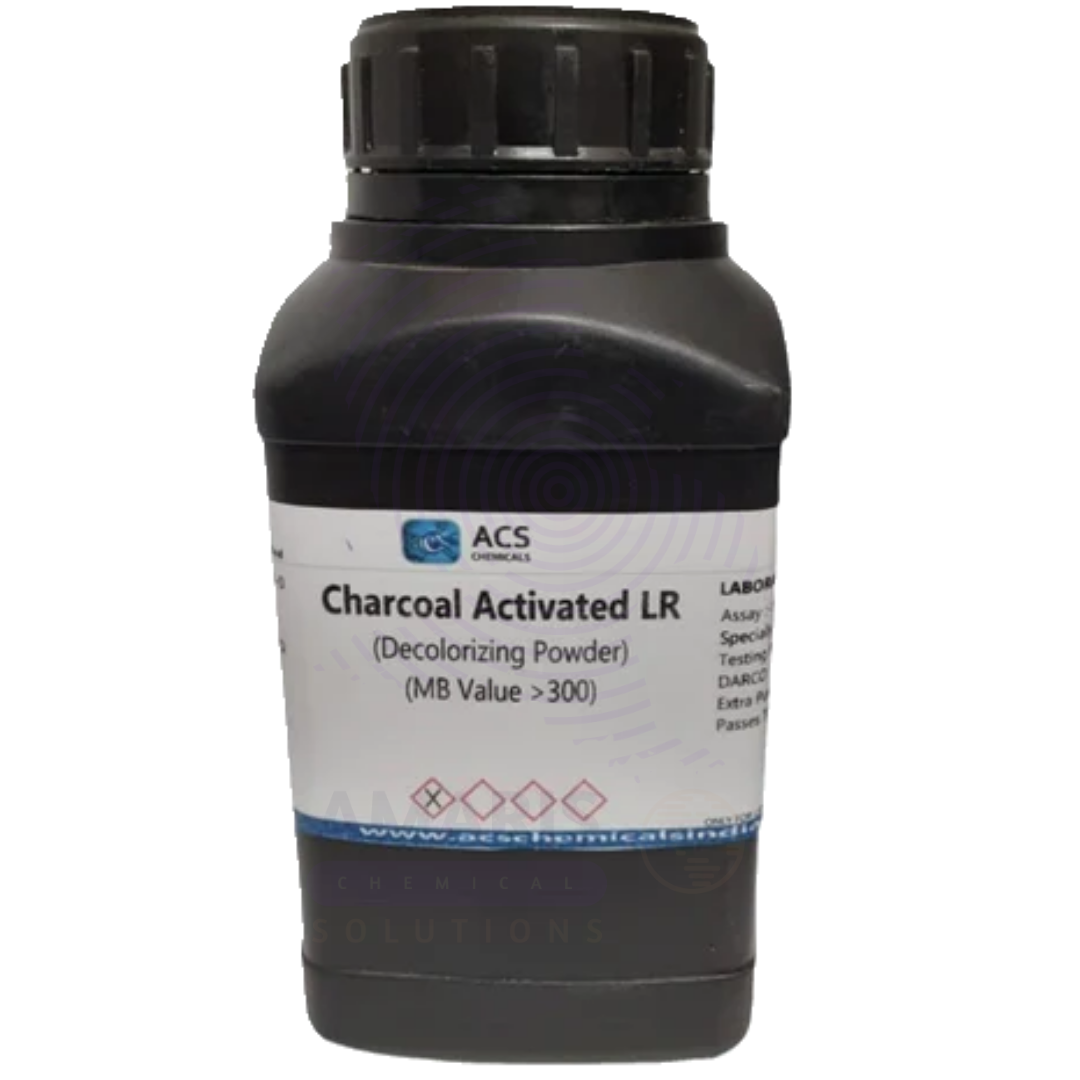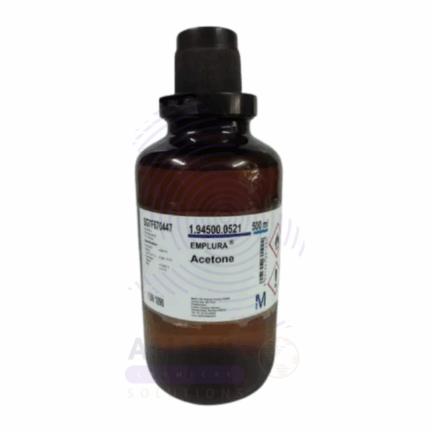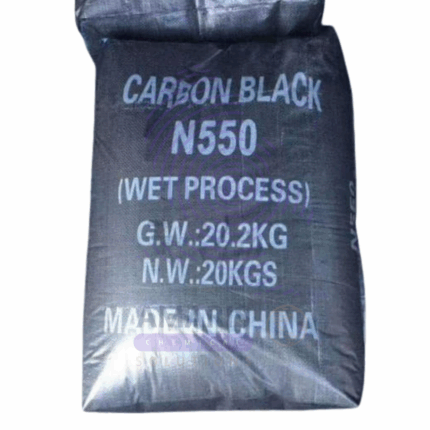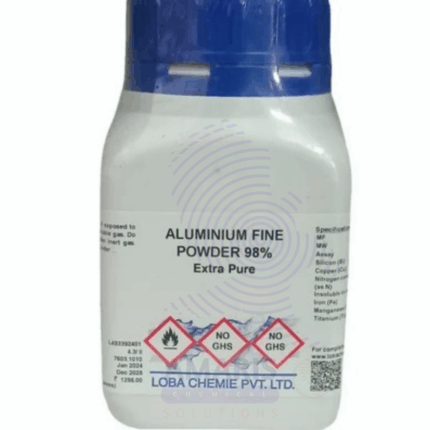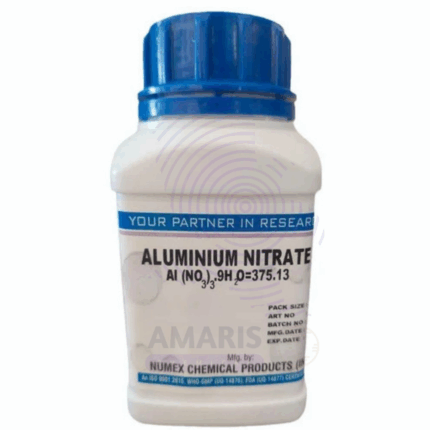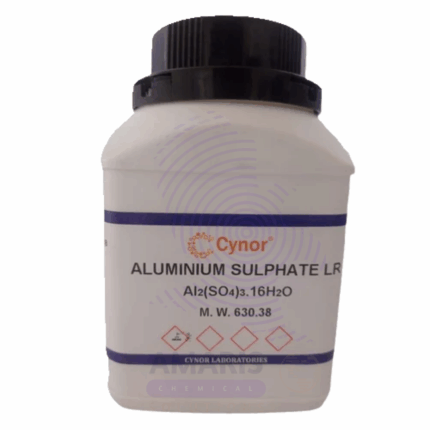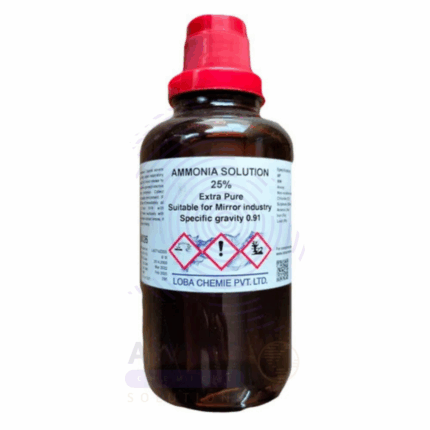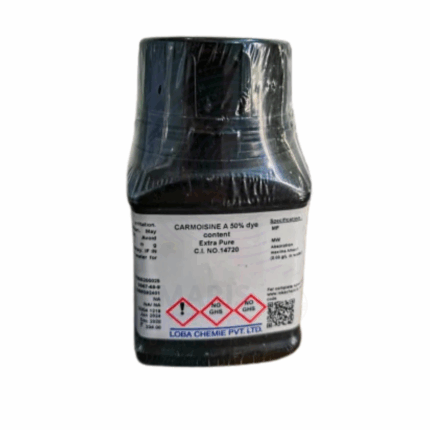
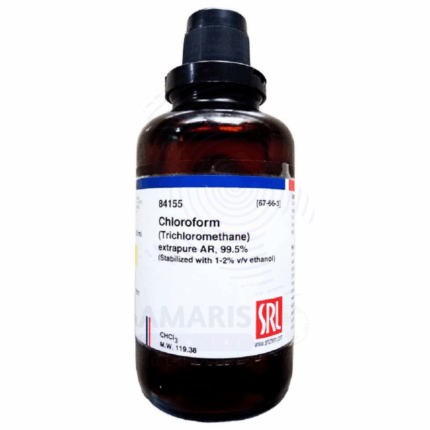
Charcoal Decolourising Powder Extra Pure
$ 19.00 Original price was: $ 19.00.$ 18.97Current price is: $ 18.97.
Charcoal Decolourising Powder Extra Pure is a high-grade activated carbon used in laboratory settings for purification and clarification processes. Its exceptional adsorptive properties make it ideal for removing color impurities, organic contaminants, and unwanted residues from chemical solutions, solvents, and extracts. This extra pure form is especially suited for sensitive analytical work, pharmaceutical preparations, and biochemical applications where high purity and minimal contamination are critical. It is commonly used in filtration experiments and in the refinement of reagents and compounds. The powder should be handled in a dry environment and stored in airtight containers to maintain its effectiveness.
Charcoal Decolourising Powder Extra Pure
Primary Uses
- Adsorption and Purification of Solutions
-
-
- Commonly used to remove colored impurities from chemical solutions by adsorbing dyes, pigments, or decomposition byproducts, especially in organic synthesis and analytical prep work.
-
- Clarification of Organic Compounds
-
-
- Especially effective in purifying recrystallized products like benzoic acid, naphthalene, or acetanilide by eliminating colored contaminants.
-
- Sample Preparation in Chromatography
- Helps pre-clean or decolorize liquid samples before chromatographic separation to avoid interference or streaking on TLC plates or columns.
Secondary Uses
- Demonstration of Adsorption Principles
- Frequently used in teaching labs to show surface adsorption processes, including comparison with other adsorbents like silica gel or alumina.
- Biochemical Preparation Support
- In some biochemical or pharmaceutical lab settings, it can clarify enzyme solutions, vitamins, or alkaloid extracts without affecting activity when used correctly.
- Filtration Experiments
-
- Often combined with vacuum filtration to demonstrate adsorption + separation techniques in lab training.
| PACK SIZE |
500 grams Plastic Tin |
|---|
1. Basic Identification Attributes
- Chemical Name: Charcoal Decolorising Powder (Activated Carbon)
- CAS Number: 7440-44-0
- HS Code: 3802.10.00
- Molecular Formula: C
- Synonyms: Activated Charcoal, Activated Carbon, Decolorising Carbon, Active Carbon
2. Physical & Chemical Properties
- Physical State: Solid, fine powder
- Color & Odor: Black powder; odorless
- Boiling Point & Melting Point: Sublimes at very high temperatures; no true melting point
- Density/Specific Gravity: ~0.4–0.5 g/cm³ (bulk)
- Solubility: Insoluble in water and organic solvents
- pH Level: ~6 to 8 (slurry in water)
- Vapor Pressure & Volatility: Not applicable (non-volatile solid)
- Flash Point: Non-flammable in powder form, but airborne dust can be combustible
- Autoignition Temperature: ~465°C (dust form)
- Viscosity: Not applicable
3. Safety & Hazard Attributes
- Hazard Class (GHS): Not classified as hazardous, but combustible as dust
- NFPA Ratings:
- Health: 1
- Flammability: 1
- Reactivity: 0
- Exposure Limits:
- OSHA PEL: 15 mg/m³ (total dust), 5 mg/m³ (respirable)
- ACGIH TLV: 1 mg/m³ (inhalable)
- Reactivity: Stable under normal conditions; avoid strong oxidizers
4. Storage & Handling Attributes
- Storage Conditions: Store in a cool, dry, well-ventilated area; away from ignition sources
- Incompatible Materials: Strong oxidizing agents (e.g., nitric acid, potassium permanganate)
- Container Type: Airtight plastic or fiber drums with inner liner
- Shelf Life & Expiration Date: ~5 years when properly stored
- Special Handling Requirements: Use gloves, dust mask, and eye protection; handle under fume hood to prevent inhalation of dust
5. Regulatory & Compliance Attributes
- Regulatory Status:
- Not listed as a hazardous substance under major regulations (OSHA, REACH, TSCA)
- Hazard Symbols (GHS): None required under normal lab use
- Transportation Restrictions: Not regulated as a hazardous material
- Waste Disposal Method: Dispose via approved chemical waste facility; follow local environmental regulations
6. Environmental & Health Impact
- Ecotoxicity: Low; minimal environmental hazard
- Persistence in Environment: Stable; not biodegradable but adsorbs contaminants
- Carcinogenicity/Mutagenicity: Not classified as carcinogenic
- Biodegradability: Non-biodegradable; physically stable in the environment
SAFETY PRECAUTIONS
- PPE Required:
- Lab coat
- Nitrile or latex gloves
- Safety goggles or face shield
- Dust mask or respirator (to prevent inhalation of fine powder)
- Handling:
- Avoid generating dust or inhaling particles.
- Use in a well-ventilated area or fume hood.
- Keep container tightly sealed when not in use.
- Storage:
- Store in a dry, cool, well-ventilated area.
- Keep away from strong oxidizers and ignition sources.
- Use non-sparking tools and explosion-proof equipment if handling large quantities.
FIRST AID MEASURES
- Inhalation:
- Move the person to fresh air immediately.
- Seek medical attention if irritation or breathing difficulty persists.
- Skin Contact:
- Wash with soap and water.
- Remove contaminated clothing.
- Seek medical attention if irritation develops.
- Eye Contact:
- Rinse cautiously with water for at least 15 minutes.
- Remove contact lenses if present.
- Get medical help if irritation continues.
- Ingestion:
- Rinse your mouth thoroughly.
- Drink water.
- Seek medical attention if symptoms develop.
FIREFIGHTING MEASURES
- Flammability: Combustible in powdered form (may cause dust explosions).
- Suitable Extinguishers:
- Dry chemical
- Carbon dioxide
- Foam (avoid using water if large amounts are involved due to dust)
- Hazards in Fire:
- May release carbon monoxide and carbon dioxide when burned.
- Firefighting Gear:
- Wear full protective clothing and self-contained breathing apparatus (SCBA).


 Preservatives(food)
Preservatives(food) Flavor Enhancers
Flavor Enhancers Acidulants
Acidulants Sweeteners
Sweeteners Antioxidants
Antioxidants Colorants(food)
Colorants(food) Nutraceutical Ingredients (food)
Nutraceutical Ingredients (food) Nutrient Supplements
Nutrient Supplements Emulsifiers
Emulsifiers
 Collectors
Collectors Dust Suppressants
Dust Suppressants Explosives and Blasting Agents
Explosives and Blasting Agents Flocculants and Coagulants
Flocculants and Coagulants Frothers
Frothers Leaching Agents
Leaching Agents pH Modifiers
pH Modifiers Precious Metal Extraction Agents
Precious Metal Extraction Agents
 Antioxidants(plastic)
Antioxidants(plastic) Colorants (Pigments, Dyes)
Colorants (Pigments, Dyes) Fillers and Reinforcements
Fillers and Reinforcements Flame Retardants
Flame Retardants Monomers
Monomers Plasticizers
Plasticizers Polymerization Initiators
Polymerization Initiators Stabilizers (UV, Heat)
Stabilizers (UV, Heat)
 Antifoaming Agents
Antifoaming Agents Chelating Agents
Chelating Agents Coagulants and Flocculants
Coagulants and Flocculants Corrosion Inhibitors
Corrosion Inhibitors Disinfectants and Biocides
Disinfectants and Biocides Oxidizing Agents
Oxidizing Agents pH Adjusters
pH Adjusters Scale Inhibitors( water)
Scale Inhibitors( water)
 Antioxidants(cosmetic)
Antioxidants(cosmetic) Emollients
Emollients Fragrances and Essential Oils
Fragrances and Essential Oils Humectants
Humectants Preservatives
Preservatives Surfactants(cosmetic)
Surfactants(cosmetic) Thickeners
Thickeners UV Filters
UV Filters
 Fertilizers
Fertilizers Soil Conditioners
Soil Conditioners Plant Growth Regulators
Plant Growth Regulators Animal Feed Additives
Animal Feed Additives Biostimulants
Biostimulants Pesticides (Herbicides, Insecticides, Fungicides)
Pesticides (Herbicides, Insecticides, Fungicides)
 Active Pharmaceutical Ingredients (APIs)
Active Pharmaceutical Ingredients (APIs) Excipients
Excipients Solvents(pharmaceutical)
Solvents(pharmaceutical) Antibiotics
Antibiotics Antiseptics and Disinfectants
Antiseptics and Disinfectants Vaccine Adjuvants
Vaccine Adjuvants Nutraceutical Ingredients (pharmaceutical)
Nutraceutical Ingredients (pharmaceutical) Analgesics & Antipyretics
Analgesics & Antipyretics
 Analytical Reagents
Analytical Reagents Solvents(lab)
Solvents(lab) Chromatography Chemicals
Chromatography Chemicals Spectroscopy Reagents
Spectroscopy Reagents microbiology-and-cell-culture-reagents
microbiology-and-cell-culture-reagents Molecular Biology Reagents
Molecular Biology Reagents Biochemical Reagents
Biochemical Reagents Inorganic and Organic Standards
Inorganic and Organic Standards Laboratory Safety Chemicals
Laboratory Safety Chemicals Specialty Laboratory Chemicals(Special Laboratory Equipment)
Specialty Laboratory Chemicals(Special Laboratory Equipment)
 Demulsifiers
Demulsifiers Hydraulic Fracturing Fluids
Hydraulic Fracturing Fluids Scale Inhibitors(oil)
Scale Inhibitors(oil) Surfactants(oil)
Surfactants(oil) Drilling Fluids
Drilling Fluids
 Dyes and Pigments
Dyes and Pigments Bleaching Agents
Bleaching Agents Softening Agents
Softening Agents Finishing Agents
Finishing Agents Antistatic Agents
Antistatic Agents
 Admixtures
Admixtures Waterproofing Agents
Waterproofing Agents Sealants and Adhesives
Sealants and Adhesives Curing Compounds
Curing Compounds Concrete Repair Chemicals
Concrete Repair Chemicals Anti-Corrosion Coatings
Anti-Corrosion Coatings
 Surfactants(cleaning)
Surfactants(cleaning) Builders
Builders Enzymes
Enzymes Solvents (Cleaning)
Solvents (Cleaning) Fragrances
Fragrances
 Electronic Chemicals
Electronic Chemicals Catalysts
Catalysts Lubricants
Lubricants Photographic Chemicals
Photographic Chemicals Refrigerants
Refrigerants Automotive chemicals
Automotive chemicals Pyrotechnic Chemicals
Pyrotechnic Chemicals
 Biodegradable Surfactants
Biodegradable Surfactants Bio-based Solvents
Bio-based Solvents Renewable Polymers
Renewable Polymers Carbon Capture Chemicals
Carbon Capture Chemicals Wastewater Treatment Chemicals
Wastewater Treatment Chemicals
 Pigments
Pigments Solvents(paint)
Solvents(paint) Specialty Coatings
Specialty Coatings Binders/Resins
Binders/Resins Additives
Additives Driers
Driers Anti-Corrosion Agents
Anti-Corrosion Agents Functional Coatings
Functional Coatings Application-Specific Coatings
Application-Specific Coatings
 Fresh Herbs
Fresh Herbs Ground Spices
Ground Spices Whole Spices
Whole Spices Spice Blends
Spice Blends Dried Herbs
Dried Herbs
 Leavening Agents
Leavening Agents Dough Conditioners
Dough Conditioners Flour Treatments
Flour Treatments Fat Replacers
Fat Replacers Decoratives
Decoratives Preservatives(baking)
Preservatives(baking)
 Plasticizers & Softeners
Plasticizers & Softeners Reinforcing Agents
Reinforcing Agents Adhesion Promoters
Adhesion Promoters Vulcanizing Agents
Vulcanizing Agents Antidegradants
Antidegradants Blowing Agents
Blowing Agents Fillers & Extenders
Fillers & Extenders Accelerators & Retarders
Accelerators & Retarders